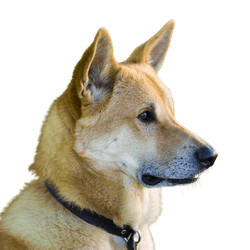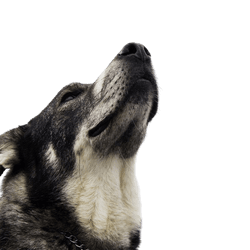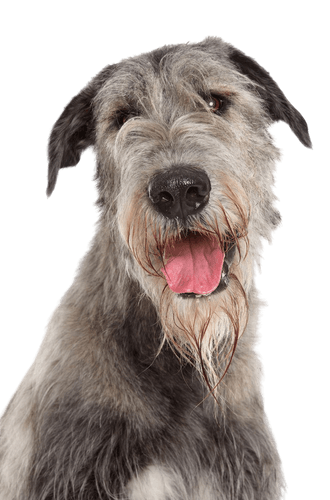
Irish Wolfhound Breed description: Character & Co
Irish Wolfhound
Facts & Origin
The Irish Wolfhound is one of the largest dog breeds in the world. In former times Irish Wolfhounds would be used for hunting wolves, which is how this big dog got its name.
What is the origin of the Irish Wolfhound?
As its name suggests, the Irish Wolfhound originates in Ireland. It is a particularly old dog breed. Its ancestors were sighthounds, which probably came to the Irish island with the Celts as early as the 3rd century. But the exact origin is not completely clear. Archaeological findings indicate that there were already large sighthounds in Ireland around 7000 BC. The Irish used these strong dogs for hunting wolves and big game. Also, Roman writings mention the Irish Wolfhounds. The Romans used them in gladiator fights. In the Middle Ages, only nobles were allowed to keep the Irish Wolfhound. In the 15th century, every English county had to keep Wolfhounds by law to protect the cattle of its farmers from wolves. With the invention of firearms, wolves were exterminated in Ireland and Great Britain. The Irish Wolfhound lost its purpose and the breed became increasingly rare. In the middle of the 19th century, a Scotsman tried to save this rare breed of dog. He crossed remaining Irish Wolfhounds with the breeds Borzoi (Russian greyhound), Great Dane and Deerhound (Scottish Deerhound). At the end of the 19th century, this re-bred Irish Wolfhound was officially recognised. The breed was classified in the FCI group 10.2 rough-haired sighthounds.

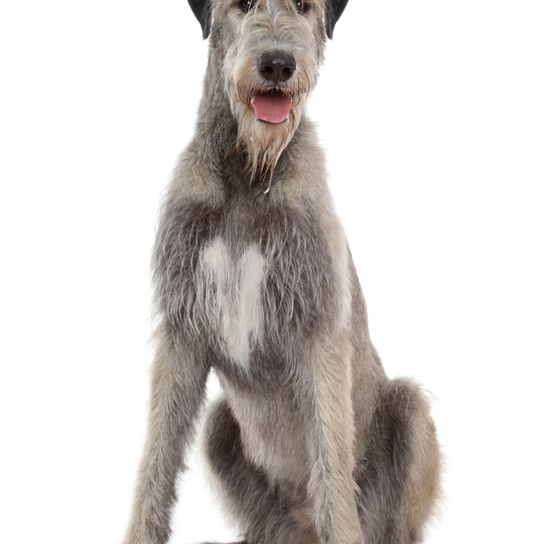

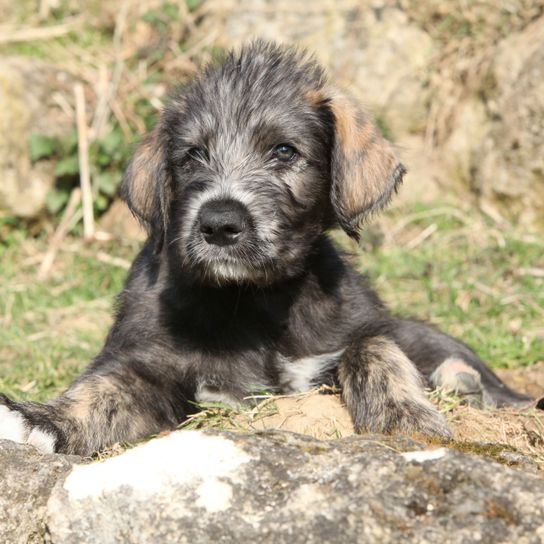
| Alternate Name | - |
| Origin | Ireland |
| Life expectancy | 6 - 10 years |
| Care requirements | high-maintenance |
| Activity level | average to high |
| FCI group | Rough-haired Sighthounds |
| AKC group | Hound Group |
| KC group | Hound Group |
Attitude, character and temperament of the breed
What are typical characteristics of the Irish Wolfhound?
-
gentle
- friendly
- good-natured
- balanced
- sensitive
- prudent
- endearing
- loyal
- adaptable
- people-oriented
Irish Wolfhounds are described as gentle giants. They are regarded as well-balanced, level-headed and lovable. They are loyal, adaptable and loving towards their owners. They are very people-oriented and like to be in close contact to their people. Despite their stately size, they like to lie on the sofa and love extensive cuddling. These dogs feel comfortable when they can live in the house with their humans. A life lived just being in the garden, yard or kennel is not enough for them. These huge dogs are amazingly sensitive. They tolerate harsh treatment even less than other dog breeds. But you should not forget that they have an innate hunting instinct and once could take on wolves. These able-bodied hunting dogs can make decisions independently. Sometimes the breed tends to be stubborn when dealing with its humans. Nowadays, they are often kept as family dogs. Dogs of this breed are well compatible with other dogs and animals. The Irish Wolfhound is less suitable as a guard dog, however. Although the giant acts as a deterrent to burglars, it usually greets strangers in a friendly manner.
Character
Usage




Health and breeding information
What are typical diseases of an Irish Wolfhound?
Irish Wolfhounds have an increased risk of developing
- stomach twists or
- heart disease.
Other typical diseases are
- Tumours, especially bone cancer
- Osteochondrosis (malformation in bone growth)
- Epilepsy and
- Portosystemic shunt (malformation of liver vessels).
In the first year of the life of an Irish Wolfhound puppy you have to pay special attention to its feeding. An Irish Wolfhound puppy grows very fast. Food that is too high in energy would be of harm to it. On the other hand however, it needs to receive important nutrients for the growth of its bones. A balanced diet is important. During its growth, the young Wolfhound should not climb stairs and, for example, not be allowed to jump out of the car. Even adult dogs should not climb stairs to protect their joints and spine.
Irish Wolfhound breeding: What should be considered when breeding an Irish Wolfhound?
Since Irish Wolfhounds do not have a high life expectancy, the highest breeding goal should be health. The VDH (Verband für das Deutsche Hundewesen) demands from its breeders that they have a heart examination every two years for parent dogs. Anyone who purchases a Wolfhound should therefore only take a dog with VDH papers. In addition, only parent animals with all the good qualities of the breed should be chosen for breeding. These Wolfdogs are gentle, balanced, level-headed and lovable. Funfact: Heidi Klum and her husband Tom Kaulitz decided to get an Irish Wolfhound in 2019 and now they have a sweet giant living with them in Los Angeles.


What are the breed characteristics of the Irish Wolfhound?
It is a giant among dogs. With a shoulder height of more than 70 centimetres, the Irish Wolfhound is one of the largest dogs. Despite their enormous size, their body does not appear massive. He has a swinging step. The large rough-haired greyhound appears slender, well-proportioned and strong. Its rough hair is quite long and can be found in different colour variations.
Appearance and coat of the Irish Wolfhound
The enormous size of the Irish Wolfhound is the first thing that catches ones attention. The large greyhound is slim and has long legs. Its rough, wiry coat can have different colours:
- grey
- black
- white
- red
- brown
- yellow
- brindled
They have dark, oval eyes and black-rimmed eyes. The ears of the huge dog are so small that they are called rose ears.
What is the average size of an Irish Wolfhound?
As already mentioned, the Irish Wolfhound is one of the largest dog breeds in the world. Wolfhound males reach a shoulder height of 81 to 95 centimetres, Wolfhound bitches grow to a height of 79 to 81 centimetres.
How much does an Irish Wolfhound weigh?
Wolfhound dogs weigh at least 54.5 kilos. Some of them can weigh up to 70 kilos. Female Wolfhounds have a minimum weight of 40.5 kilos.
What is the life expectancy of an Irish Wolfhound?
As with all large dog breeds, the Irish Wolfhound unfortunately has a low life expectancy. This is only five to ten years. According to studies, a large proportion of Wolfhounds die before they even get to the age of five.
| Fur length | medium |
| Fur | rough-haired |
| Ear shape | Triangle |
| Tail | short |
| Anatomy | slim |
| Size ♀ | 71 - 68 cm |
| Weight ♀ | 40 - 50 kg |
| Size ♂ | 79 - 89 cm |
| Weight ♂ | 54 - 60 kg |
| Suitable For | - |
Colors




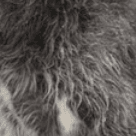




Known Diseases
Joint problems
Especially due to overweight, joint problems can occur in dogs.
Heart disease
Can occur frequently in dogs and can sometimes be treated with medication.
Bone Cancer
May occur with age.
Gastric torsion
Gastric torsion is a disease in which the stomach rotates around its own longitudinal axis. The cause of the disease is not known.
FAQ
-
An Irish Wolfhound costs 2000 Euro and is very rare to find. Watch out for a serious breeding.
-
Large dog breeds also eat relatively much. With an average weight of an Irish Wolfhound male approx. 1200g food is needed daily.
Other large dogs
Useful Articles
You can find articles that might interest you in the dogbible blog to match your favorite breed.
Visit our magazineto stay up to date on dog trends.
To find out more, view our Privacy Policy
Find here the breed that suits you and find out what character traits it has. Here you can also learn more about the origin, size and weight of your favorite breeds.
Matching your favorite breed, you'll find articles that might interest you on the dogbible dog blog.
10 hotspots for hiking with dog in Austria
Dog sitter wanted - by the hour or for the holidays
Cat grass for the dog? Is there such a thing? Dangerous?

